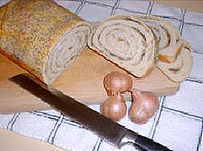Make the most of culinary herbs and spices.
All About Shallots
by Sandra Bowens

Family members often have as many differences as they have common traits. The Allium family is no different. From the plumpest Walla Walla Sweet to the most slender chive, members of the onion family cover all the bases. A sharp white onion might make you cry and a single clove of garlic can make you breathe fire. The one thing they all have in common is that they start from a bulb.
This is where the dainty shallot first shows its individuality. Unlike the rest of the Allium family, the shallot multiplies as it grows. You start with one bulb early in the spring and you may end up with ten at the end of the season.
The shallot has other differences as well. The taste has been described as sweeter than the mildest onion. A slight apple flavor mingles with the familiar onion bite. Shallots have been shown to be more digestible than the rest of the family and have less of an impact on the breath.
The botanical name for shallots used to be Allium ascalonicum and they were once called eschalots. This name is associated with the ancient city of Ascalon in Palestine. The Crusaders introduced shallots to Europe on their return from the Middle East. Now the botanical name has been changed to match the onion, Allium cepa.
Two varieties of shallots exist. The ruddy-brown bulb is common in the United States. A pink skinned variety that is longer and thinner, prized by cooks, is more readily available in other parts of the world. Shallots are similar in size to a head of garlic and often have two bulbs within their papery skin. This skin and the outer layer of each bulb are peeled away, leaving what appears to be a small onion.
Shallots cook quickly, maintaining a silky texture. They can be used in place of onions, especially if they are to be served raw where their more delicate flavor can be appreciated. Shallots are a common ingredient in sauces and salad dressings. Try them in compound butters or roasted whole for an interesting side dish.
Although the growing season is long, shallots are easy on the gardener. An old adage tells us what to do: "plant on the shortest day, lift on the longest day." They can be grown from plants or sets, like onions. The bulbs are perennial shooting out leaves that reach about two feet. Also like onions, they should be harvested when the leaves begin to turn brown and wilt. Shallots will rarely bloom.
Look for shallots alongside the other onions and garlic at the market. They have a shorter shelf life than some of their cousins but that's okay. Once you start using shallots, you will find it is hard to keep them on hand.
Shallot Spiral Bread
1 Tablespoon butter
1 Tablespoon olive oil
1 teaspoon dried thyme or 1 Tablespoon fresh minced leaves
1 1/2 cups thinly sliced shallots (about 5 or 10, depending on size)
Salt and pepper, to taste
1 cup warm water
2 1/2 teaspoons yeast
1 Tablespoon sugar
3 cups flour, approximately
2 Tablespoons butter, at room temperature
1 teaspoon salt
non-stick spray
1 egg white, beaten
Poppy seeds
In a medium skillet, melt the butter with the olive oil over medium-heat. Add the dried thyme (if using fresh thyme, add it during the last 5 minutes of cooking) and then the shallots, mixing well to coat with the butter mixture. Cook slowly until very soft, about 15 minutes, stirring frequently so that the shallots don't brown too much. Remove from heat, stir in salt and pepper and set aside.
Pour the warm water into a large mixing bowl. Sprinkle with the yeast and the sugar; stir and allow to sit for 5 minutes. Mix in 1 cup of the flour along with the butter and salt. Stir until well blended, breaking up the butter as needed. Add another 1 1/2 cups of the flour. Stir until the dough "cleans the bowl." Turn it out onto a lightly floured board or counter top. Knead for 10 minutes, adding as little flour as possible. Ideally, after 5 minutes you will have a ball of dough that is slightly tacky but not sticky and will not need to have flour on your board.
Shake out any excess flour from the mixing bowl and coat with the non-stick spray. Form the dough into a ball, place in the bowl and lightly coat the top with the spray. Cover loosely with plastic wrap. Allow the dough to rise in a warm place until doubled in size, about 45 minutes.
Punch the dough down and turn it out onto a lightly floured surface. Use a rolling pin to form a rectangle that measures 9" by 22". Spread the shallot mixture in a thin, even layer over the dough. Beginning at one long end, roll the dough into a tight loaf shape. Pat the ends in and fit it into a greased loaf pan, seam side down. Cover loosely with plastic wrap and allow to rise again until it has risen over the top of the pan, 30-45 minutes. Meanwhile, preheat the oven to 375 degrees.
Before transferring the loaf to the oven, brush the beaten egg white on top and sprinkle with poppy seeds. Bake for 20-25 minutes, until the top is browned and the bread has reached an internal temperature of 180-190 degrees (F). Cool in pan on a rack for 10 minutes; remove from pan and cool completely before slicing.
Cook's note: If you don't want to go to the trouble of making the spiral, work the shallot mixture into the dough during the last five minutes of kneading.
Here's one that's full of our favorite recipes because we wrote the book! It is also full of information, helpful hints and ideas for using herbs and spices in your kitchen.
Rosalind Creasy knows all about using food plants to round out your yard. She pioneered the idea 25 years ago. This updated edition includes 300 inspiring photographs.
Authentic yet modern Middle Eastern cooking at your fingertips and arranged in alphabetical order at that.
This site's readers loved the first edition of this book. Comprehensive information about all your favorite seasonings.
Illustrations abound in this comprehensive and informative companion for the gardener and the cook.
These darlings of the blogosphere take on classic desserts in their own quirky style.








